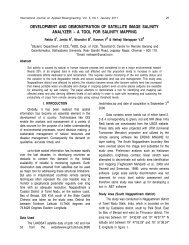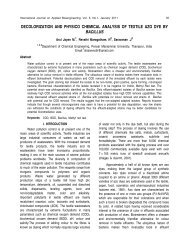Download Full Paper - Sathyabama University
Download Full Paper - Sathyabama University
Download Full Paper - Sathyabama University
Create successful ePaper yourself
Turn your PDF publications into a flip-book with our unique Google optimized e-Paper software.
Ganeshkumar et al : Depolyment of Fair Share and Smart Start Technique for Optimal Use...<br />
proposed system for which the fairness index is 0.9365.<br />
From this it is clear that fairness index of proposed system<br />
is higher than that of existing system.<br />
IV. Simulation and Results<br />
The proposed technique is implemented in ns2 Simulator.<br />
Performance of the TCP is compared with the proposed<br />
technique and existing scheme. Number of node is taken as<br />
30. The TCP statistics for a simulation run of 100 seconds<br />
time period, number of nodes 30, Node placement –<br />
Uniform, Mobility Random way point. Free space<br />
propagation is used Source and destination pair is<br />
considered as node 5 and node 25 respectively. Channel<br />
capacity is chosen as 2 Mbit/sec. Dynamic source routing<br />
and IEEE 802.11a is used as the routing and MAC protocol.<br />
FTP is used as the application layer protocol. Packet size of<br />
512, 1024, 2048 bytes are used. Simulation is conducted for<br />
100 seconds. 10 simulation runs are made and the average<br />
value is taken as the data point for result. The comparison<br />
between the existing and proposed technique is shown in<br />
the pie chart in Fig. 1 and 2.<br />
Proposed system<br />
1.02<br />
1<br />
0.98<br />
0.96<br />
0.94<br />
0.92<br />
0.9<br />
0.88<br />
0.86<br />
0.84<br />
Link Utilisation Existing system<br />
Link Utilisation Chart<br />
512 1024<br />
Sement Size<br />
2048<br />
Fig. 1. Link Utilization Chart<br />
Comparison of Fairness Index<br />
Proposed System<br />
1<br />
0.98<br />
0.96<br />
0.94<br />
0.92<br />
0.9<br />
0.88<br />
0.86<br />
0.84<br />
0.82<br />
0.8<br />
Fairness Index Existing System<br />
Based<br />
on Rtt<br />
Based<br />
on Load<br />
Fig. 2. Comparison of Fairness Index.<br />
Link utilization = offered load/ maximum capacity. Link<br />
utilization is computed for packet size of 512, 1024, and<br />
2048 bytes. If the link utilization is 1 then, the capacity of<br />
the link is used efficiently to 100 percentage. In the link<br />
utilization chart it can be seen that the link utilization of<br />
proposed system is greater than that of proposed system.<br />
Fairness index comparison chart reveals that the fairness<br />
ratio of proposed system is greater than that of existing<br />
system. Therefore the simulation result shows the same<br />
result with that of the numerical example discussed in<br />
section 3.<br />
V. Smart Start (SS)<br />
The slow start and congestion avoidance algorithms<br />
must be used by a TCP sender to control the amount of<br />
outstanding data being injected into the network. To<br />
implement these algorithms, two variables are added to<br />
the TCP per-connection state. The congestion window<br />
(cwnd) is a sender-side limit on the amount of data the<br />
sender can transmit into the network before receiving an<br />
acknowledgment (ACK), while the receiver's advertised<br />
window (rwnd) is a receiver-side limit on the amount of<br />
outstanding data. The minimum of cwnd and rwnd<br />
governs data transmission. In slow start after, the first<br />
successful transmission and acknowledgement of a TCP<br />
segment increases the window to two segments. After<br />
successful transmission of these two segments and<br />
acknowledgements completes, the window is increased to<br />
four segments. Then eight segments, then sixteen<br />
segments and so on, doubling from there on out up to the<br />
maximum window size advertised by the receiver or until<br />
congestion finally does occur. In slow start even though,<br />
the window size is increased faster the connection takes<br />
much long time to reach the maximum utilization of<br />
bandwidth available in the link. To overcome this, a<br />
procedure such as increasing the window size either in the<br />
multiples of 3 or 4 is proposed rather than increasing the<br />
window size in multiples of 2 for each acknowledgement.<br />
A. Assumptions<br />
RTT=500 unit, Acknowledgement is received for each<br />
RTT, Bandwidth used is calculated by Used bandwidth =<br />
Sender Window size (SWS) * 3. The units of all the<br />
parameter are treated as general (it may be ms for RTT, #<br />
of bytes for Sender Window size, Kbps/Mbps for Used<br />
Bandwidth)<br />
In the table 5 sender window size is increased by 2 for each<br />
RTT ie) Sender Window Size = Previous Sender Window<br />
Size *2. if the unit of RTT is considered as ms, then from<br />
the table it can be proved that that it takes 8 seconds till the<br />
TCP flow reaches 100MB/s at a RTT of 500ms.<br />
35









